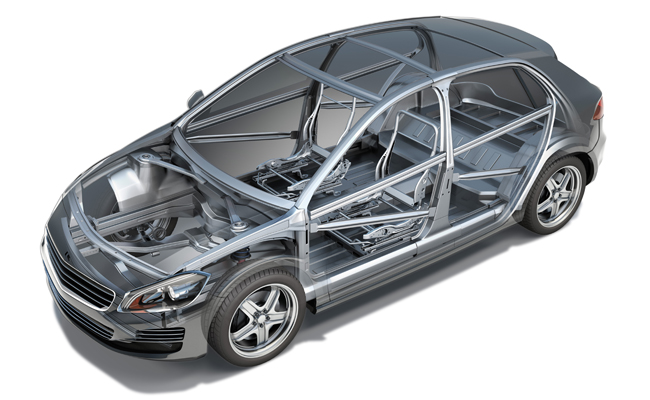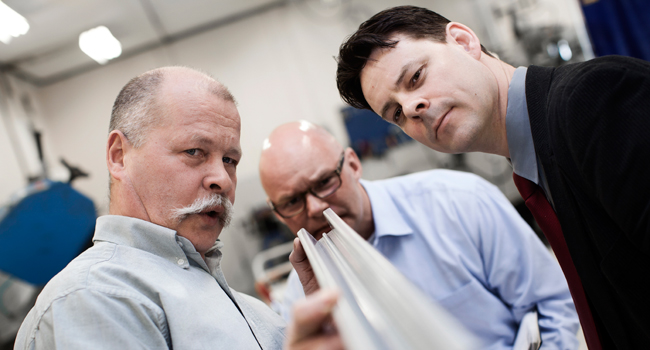Forming – the secret to ensuring robustness in high-strength steel applications

Although steel starts out as sheet metal, it can be transformed into any number of rounded or “formed” shapes using a series of steps that include cutting, pressing and trimming.
Forming is used in a wide variety of industrial applications – from parts for tractors and trailers, to cranes booms and other machinery and components. These industrial application areas typically use a high-performance steel that offers good bending performance, but is rarely used for complex, high-strength components such as those used in the automotive industry.
Since crash safety moved to the top of the agenda for car manufacturers, ultra-high-strength steel has become more established as the material of choice for components such as bumper reinforcements, door impact beams, seat frames and mechanisms, as well as chassis components. In fact, it is largely due to the widespread use of formed ultra-high-strength steel that OEMs these days are able to achieve five-star crash ratings. This material has also allowed OEMs to reduce component weight by up to 40 percent, cut costs, boost efficiency in their production, and develop a slew of innovative solutions that would not have been possible decades ago.
Thomas Müller is a Manager at SSAB’s Knowledge Service Center and an expert in steel forming. He explains that the quality of the steel and its formability are among the most crucial factors in ensuring the safety of car drivers and passengers.
“In the average car you’ll find hundreds of parts that have been formed into geometric shapes to achieve certain characteristics,” he says. “For example, chassis components require a high level of stiffness and good fatigue properties, whereas crash safety components need to withstand impact, absorb energy and deform in a specific way in the event of a collision.”
One of the strongest advanced high-strength and ultra-high-strength steels on the market is Docol from SSAB. It is one of the most popular steel alternatives in the transportation and automotive industries due to its superior quality, consistency and robustness. Furthermore, it also offers outstanding formability – something that Müller explains is not taken for granted in the industry.
“It’s a common misconception that high-strength steel isn’t suitable for forming because of its poor elongation results in tensile testing. In fact, there are more reliable ways to test the formability of high-strength steel, which prove that it’s fully possible to form it into complex shapes,” he says, adding that many OEMs are still choosing softer grades of steel and missing out on the competitive advantage offered by high-strength steels.
Another major advantage of Docol, apart from its outstanding strength, is that it is an extremely consistent material choice.
“Docol always runs through the same lines and offers the same mechanical properties from coil to coil, so customers never need to adapt their processes from one batch to another,” says Müller.
Automotive manufacturers use Docol in components such as seats, seat tracks, bumpers and rocker panels. The use of Docol for chassis components, including suspension arms, is also becoming more widespread since the launch of SSAB’s new cooling line where it produces steel grades such as Docol HR 1000HE, 800HE and 800CP. Since these products were launched last year, the chassis component market has been growing consistently for Docol and SSAB.
Müller explains that there are three different forming methods that can be used on high-strength steels. The first is cold stamping, which is the most common forming process on automotive production lines. Cold stamping is typically used for components such as door beams, seat components and crash boxes. The second is roll forming, typically used to form the steel used for bumpers, rocker panels and seat tracks. Finally, hot forming is less common and used for complex, shaped impact-resistant components.
Today, SSAB’s cold-forming steels are available in up to 1,700 MPa for cold-rolled grades and in excess of 2,200 MPa for press hardening steel.
“Our strategy includes continuous improvement. We have taken a great step forward in the automotive segment and are now looking forward to the third generation of AHSS. Ten years ago the industry was using steels of just 800-1,000 MPa. Since then automotive safety has greatly improved,” says Müller.

Most SSAB products are formed using either cold stamping or roll forming. One company that has extensive experience of developing products made of Advanced High-Strength Steel (AHSS) is US-based Shape Corp.h, which specializes in designing, developing and manufacturing crash safety components and other applications for the automotive industry.
Tom Johnson, Shape’s Global Director of Product Engineering, explains that the company has been using Docol from SSAB in impact energy management applications, such as door beams and bumper beams, for close to 10 years. More recently, it also started incorporating Docol into some of its structural applications.
“The excellent mechanical properties of AHSS allow us to design geometries that are suitable for these demanding applications, enabling us to create a high-quality, high-strength, low-weight product,” he says.
Brian Oxley, Shape’s Product Manager for Advanced Product Development in Metallics, explains that Docol has a number of properties that make it suitable for the state-of-the-art products that Shape develops. These include bendability, which is crucial to roll forming as the geometries are created through bending; flatness, which is required to ensure consistency and quality; and weldability and weight reduction, both of which are key to many automotive components.
“The reason formability is so essential is that it allows us to fully utilize the strength of the material,” concludes Oxley. “A material can have all the strength in the world but, if it isn’t formable, you can’t make a part out of it.”
About Docol
Docol is SSAB’s specialized “automotive steel,” dedicated to enabling carmakers to build safe and robust bodies, chassis, crash details and wheels. All Docol grades are developed to meet the demands of cost-effective, automated, high-volume production of parts with complex geometries. It is often used in stamping and roll forming processes. Docol is particularly well suited to cold forming – an area in which SSAB has extensive expertise that it shares with its customers to enable them truly to benefit from the advantages that Advanced High-Strength Steel has to offer.
Text: Isabelle Kliger